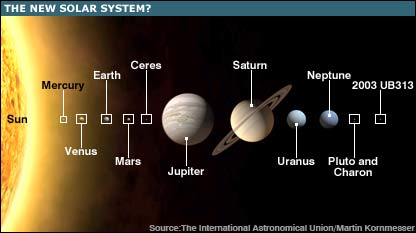Counting from the sun: Mercury, Venus, Earth, Mars, Jupiter, Saturn, Uranus, Neptune and Pluto.
At a conference in Prague, 2,500 astronomers are going to vote on a proposal to increase this number to 12. Among the celestial bodies about to be upgraded to planetary status will be the asteroid Ceres, located between Mars and Jupiter, the moon to Pluto called Charon as well as a body prosaically called 2003 UB313, sometimes referred to as Sedna.

The basis for this re-evaluation is a new scientific definition of a planet which uses gravity as the determining factor.
According to this definition, two conditions must be satisfied for an object to qualify as a planet:
- The object must be in orbit around a star, but must not itself be a star
- It must have enough mass for the body's own gravity to pull it into a nearly spherical shape
Just to give you an idea of the distances involved: Neptune is 2,795,084,800 miles from the sun. In a car, travelling at 55 mph, it would take 6,381 years to reach Neptune if you were to drive 24 hours a day non-stop. Even in a space ship, travelling nearly a thousand times faster, a journey to Neptune takes 12 years. The Voyager II spaceprobe was launched in 1977, and crossed the orbit of Neptune in 1989. Even the light from the sun itself takes 7 hours to reach this planet.
More info in this article from the BBC website.












This is very interesting. Thanks! My son will love this info!
ReplyDeletePamela
I love astronomy and was a big Carl Sagan fan. He could explain astrophysics in a way that could be understood! I've read so many books on astronomy and been up to the top of Mauna Kea on Hawaii where all the big space telescopes are. Thanks for the info! Jeannette xx
ReplyDeletegood job Guido!
ReplyDelete\hey whyare they taking Pluto out of the planet category do you know?
nat